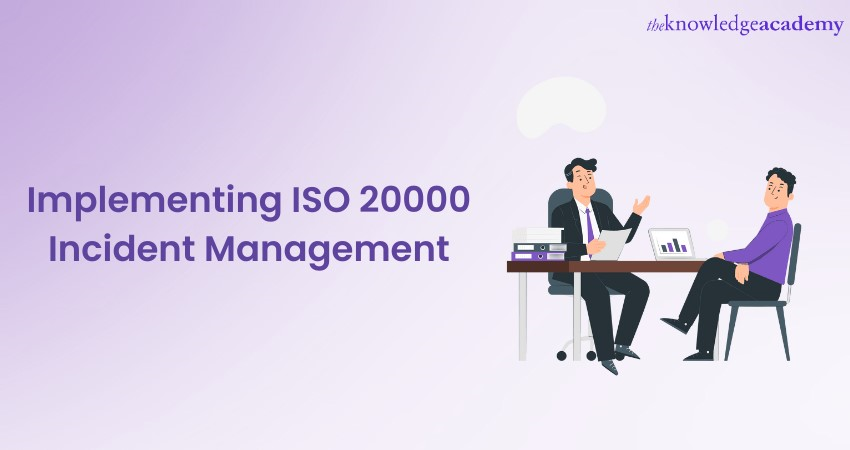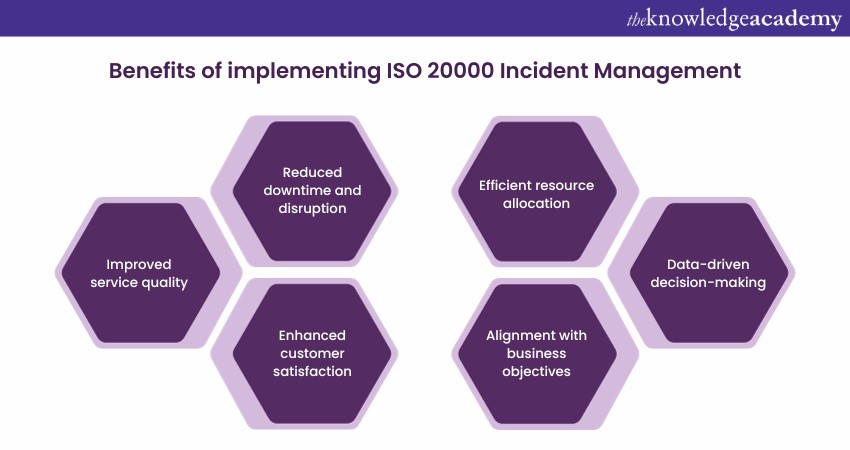We may not have the course you’re looking for. If you enquire or give us a call on +91-181-5047001 and speak to our training experts, we may still be able to help with your training requirements.
We ensure quality, budget-alignment, and timely delivery by our expert instructors.

The seamless functioning of IT services is essential for organisations across industries in the modern business landscape. To ensure consistent delivery of high-quality IT services, the International Organisation for Standardisation (ISO) proposed ISO 20000 – a globally recognised standard for IT service management. At the heart of ISO 20000 is Incident Management, a critical process that focuses on identifying, resolving, and mitigating disruptions to IT services, as outlined in the ISO 20000 Implementation Guide.
This blog explores implementing ISO 20000 Incident Management, understanding its benefits and role in elevating modern organisations towards a seamless IT service environment.
Table of Contents
1) Understanding ISO 20000 Incident Management
2) Benefits of implementing ISO 20000 Incident Management
a) Improved service quality
b) Reduced downtime and disruption
c) Enhanced customer satisfaction
3) Key steps to implement ISO 20000 Incident Management
4) Conclusion
Understanding ISO 20000 Incident Management
ISO 20000, a globally recognized standard for IT service management, places significant emphasis on incident management as a critical pillar within its framework. Incident management revolves around swiftly addressing and rectifying service disruptions, ensuring a seamless experience for customers and stakeholders. These disruptions can range from minor security events vs incidents to major outages. Let's dive deeper into the nuances of ISO 20000 Incident Management:
a) A holistic approach to incident resolution: ISO 20000 Incident Management extends beyond immediate technical fixes. It encompasses a systematic approach that involves multiple stages, each contributing to the seamless restoration of services while minimising adverse impacts on the organisation's functionality and reputation.
b) Incident identification and categorisation: Central to ISO 20000, incident management involves meticulous identification and categorisation of incidents. These incidents are classified based on severity and potential impact, enabling organisations to prioritise their responses effectively and allocate resources where they are most needed.
c) Prioritisation for effective resource allocation: Incident prioritisation is a critical step in the ISO 20000 framework. It ensures that incidents with the most significant potential impact are addressed promptly, while those with lower impacts receive attention in due course. This strategic allocation of resources optimises incident management efforts.
Learn ISO 20000 principles and processes; sign up for our ISO 20000 Training now!
Benefits of implementing ISO 20000 Incident Management
Among the many Benefits of ISO 20000, Incident Management brings various benefits beyond resolving disruptions. These advantages enhance service quality, improve operational efficiency, and increase stakeholder satisfaction. Let's explore the key benefits in detail:

1) Improved service quality:
a) ISO 20000 Incident Management ensures a systematic approach to addressing incidents, leading to faster and more accurate resolutions.
b) Organisations can prevent recurring incidents by identifying and addressing root causes, resulting in a higher overall service quality.
2) Reduced downtime and disruption:
a) Swift incident response and resolution minimise service downtime, allowing organisations to maintain business continuity and productivity.
b) Effective incident management minimises disruptions' negative impact on internal processes and customer experiences.
3) Enhanced customer satisfaction:
a) Rapid resolution of incidents leads to enhanced customer satisfaction as disruptions are minimised, and services remain uninterrupted.
b)Transparent communication throughout the incident lifecycle builds customer trust, showcasing the organisation's commitment to service excellence.
4) Efficient resource allocation:
a) Incident prioritisation helps allocate resources effectively, ensuring critical incidents receive immediate attention.
b) Organisations optimise resource allocation based on incident severity and impact, leading to efficient operations and minimised costs.
5) Alignment with business objectives:
a) ISO 20000 Incident Management aligns incident resolution with broader business objectives, enhancing the overall value delivered to stakeholders.
b) Organisations support their strategic goals and long-term vision by minimising disruptions and maintaining service levels.
6) Data-driven decision-making:
a) Comprehensive incident data collection and analysis enable organisations to recognise trends, patterns, and areas for improvement.
b) Data-driven insights guide informed decisions to prevent incidents, enhance processes, and drive continuous improvement.
Ready to become an ISO 20000 Incident Management expert? Sign up for our ISO 20000 Lead Auditor Training now!
Key steps to implement ISO 20000 Incident Management
Implementing ISO 20000 Incident Management involves a well-structured approach that ensures effective incident response, resolution, and continuous improvement. The following vital steps guide organisations in successfully adopting ISO 20000 Incident Management practices:
1) Gap analysis and readiness assessment:
a) Assess current practices: Evaluate existing incident management processes to identify gaps between current practices and ISO 20000 requirements.
b) Understand organisational readiness: Determine the organisation's readiness for adopting ISO 20000 Incident Management by considering resources, culture, and technology.
2) Policy and process definition:
a) Develop incident management policy: Define a comprehensive incident management policy that outlines the organisation's commitment to addressing incidents promptly and effectively.
b) Create incident management processes: Design processes that align with ISO 20000 standards, detailing how incidents will be categorised, prioritised, logged, tracked, and resolved.
3) Incident categorisation and prioritisation:
a) Categorise incidents: Create a transparent incident categorisation scheme based on impact, urgency, and potential consequences.
b) Establish prioritisation criteria: Define criteria for prioritising incidents, considering business impact, customer needs, and service level agreements.
4) Incident logging and tracking:
a) Select logging mechanisms: Choose suitable tools or systems for logging incidents, ensuring that incident details are captured accurately.
b) Implement tracking processes: Develop procedures to track incidents from identification to resolution, enabling effective monitoring and reporting.
Take your IT services to the next level! Download the ISO 20000 Implementation Guide and follow a step-by-step approach for seamless implementation.
5) Incident resolution and closure:
a) Root cause analysis: Conduct a thorough root cause analysis to identify underlying factors contributing to incidents.
b) Implement effective resolution: Define standardised resolution procedures involving collaboration among technical teams and stakeholders.
c) Validation and closure: Ensure incidents are fully resolved, validated, and closed before being marked as resolved.
Master ISO 20000 requirements with the ISO 20000 PDF—download today!
6) Continuous improvement:
a) Data analysis: Regularly analyse incident data to identify trends, recurring issues, and opportunities for improvement.
b) Implement lessons learned: Apply insights from incident analysis to refine processes, update policies, and prevent future incidents.
c) Feedback loop: Establish a feedback loop to integrate improvements into incident management practices continually.
7) Roles and responsibilities:
a) Define incident management roles: Clearly outline the roles and responsibilities of individuals involved in incident management, including incident coordinators, technicians, communication teams, and management stakeholders.
b) Establish escalation procedures: Develop escalation paths for incidents that require higher-level intervention, ensuring swift and appropriate action.
8) Tools and technologies for ISO 20000 Incident Management:
a) Select suitable tools: Choose IT service management tools that facilitate incident logging, tracking, communication, and data analysis.
b) Implement automation: Integrate automation where applicable to streamline incident management processes and improve efficiency.
9) Training and awareness:
a) Training programs: Design and deliver training programs to educate staff members about ISO 20000 Incident Management principles, processes, and best practices.
b) Raise awareness: Foster a culture of incident awareness and prompt reporting among all employees to ensure timely incident identification.
10) Documentation and reporting:
a) Document incident procedures: Create comprehensive documentation detailing incident management processes, roles, responsibilities, and escalation procedures.
b) Generate reports: Develop reporting mechanisms to track incident metrics, performance indicators, and improvements over time.
Conclusion
Implementing ISO 20000 Incident Management is essential to resilient IT service delivery. Organisations can enhance customer satisfaction and operational efficiency by adhering to standardised processes, aligning services with business goals, and fostering a culture of continuous improvement to ensure rapid incident resolution.
Unlock your potential in IT service management; sign up for our ISO 20000 Lead Implementer Training now!
Upcoming IT Service Management Resources Batches & Dates
Date
 ISO 20000 Foundation
ISO 20000 Foundation
Mon 2nd Jun 2025
Mon 1st Sep 2025
Mon 17th Nov 2025






 Top Rated Course
Top Rated Course



 If you wish to make any changes to your course, please
If you wish to make any changes to your course, please


